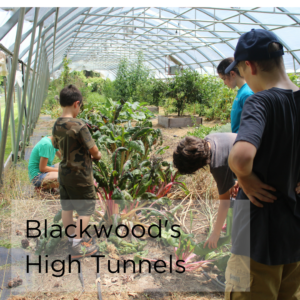 For some time now, Blackwood has been investing many growing seasons into our structures lovingly referred to as The High Tunnels.
For some time now, Blackwood has been investing many growing seasons into our structures lovingly referred to as The High Tunnels.
The High Tunnels are the large, white, rounded structures you may have seen crisscrossing the land. The tunnels stretch an astounding 168 ft. long (as long as a 17 floor building is high) with walls all around that can crank up or down as needed.
Inside the tunnels is a Mediterranean/Tropical oasis. Even in the winter months, the tunnels can remain humid, allowing all sorts of crops, like oranges and bananas, that cannot tolerate any cold to thrive year round. The versatility with the rolling walls is invaluable: if there is an issue outside of the tunnels, the walls protect the crops inside from contamination or pests; a problem inside the tunnels can also be contained from the outside world and exterminated while the tunnels cook in the sun.
Why did Blackwood get the tunnels?
Blackwood founder and farmer Cath Conlon said that “for [her], the tunnels were an answer.”
In Texas, we know the summer months are blazing hot, but even though we can find the air humid, for the plants, it’s anything but. When sunlight hits the ground, it sucks all of the water out, leaving plants dehydrated and wilted. With some sort of cover or shade, the heat becomes softer and leaves moisture for the plants to thrive. The High Tunnels provide that cover which lets the plants retain more water and cuts down on Blackwood’s water usage.
What is the future for the High Tunnels?
Many resilient and small farmers right now are creating Community Supported Agriculture (CSA) systems, where a group of interested consumers pay for weekly shares of the produce the farmer grows. Most of the High Tunnels will contribute to CSA farming (both for Blackwood Land and Sown & Grown).
Above all else, the ultimate goal of the High Tunnels—as is everything about Blackwood Land—is education. Through new opportunities offered by the tunnels, Blackwood wants to cultivate its environment as a place where young farmers can learn and feel supported at all times. That means using new technologies, like the High Tunnels, to give these young farmers and educators access to tools to help them research, experiment and grow.
“I want to create that kind of atmosphere [where young farmers don’t want to leave]” says Cath, “I hope we have a good start.”
